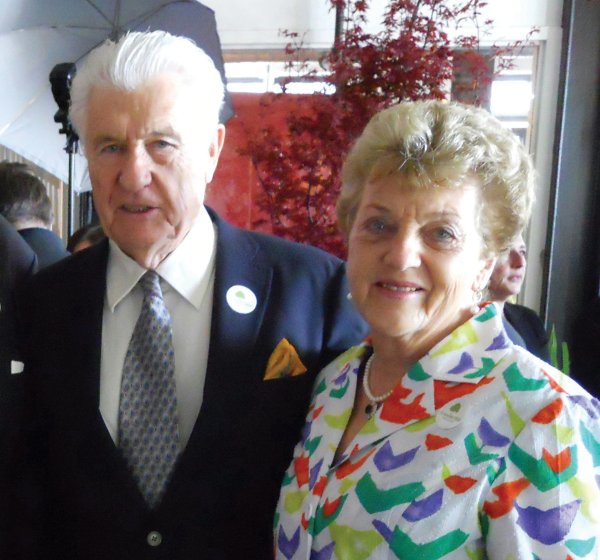
The people of St. Cuthbert’s Anglican Church have been marking the congregation’s 125th anniversary for the past year, with the festivities culminating in a Homecoming Celebration over the first weekend of October.
Why a full year to celebrate an anniversary?
“Why not?” asks Heather Conolly, who chaired the 125th anniversary committee at Leaside’s oldest church. “And we had so many different activities we wanted to plan that it seemed appropriate to make it a year-long celebration.”
The year’s events kicked off with an anniversary service last December at which Bishop the Right Rev. Patrick Yu honoured six St. Cuthbert’s members of long standing – Judy Bamford, Betty Chricton, Nancy Dorkin, Pam Sellers, Nancy Wahlroth and Ken Wantz.
Four special concerts were held during the year and two capital projects completed – the restoration of the Bayview doors and the preservation of the stained glass windows. A volunteer clean-up in the Don Valley marked ‘Creation Care Weekend’ coinciding with Earth Day in April. And three of the church’s previous incumbents – the Ven. Dr. Michael Thompson, the Rev. Canon Beth Benson and the Rev. Katy Waugh – returned to visit and worship with the congregation on different Sundays earlier this fall.
Capping the year’s celebrations, Homecoming Weekend included a gala dinner on Saturday, October 1, marking the 126th anniversary of the actual date – October 1, 1890 – when the first service was held in a wooden frame church on the site where St. Cuthbert’s Church now stands. A year earlier, in October 1889, the Rev. Tom Paterson, Rector of Christ Church Deer Park, had begun holding services in homes near the present site of St. Cuthbert’s. In early 1890, William Lea (for whom Leaside is named), in support of Paterson’s efforts, donated a half acre on the northwest corner of his property in Lot 13 of the 3rd Concession of York Township, “as a site for a mission church, with the proviso that no interments take place on the property.”
This information comes from “A Sitting Tour of St. Cuthbert’s,” a collection of columns written for the parish newsletter by church archivist and lifetime member Arthur Sellers (1923-2009). The columns contain no shortage of interesting and sometimes humorous anecdotes, and demonstrate that the stories of St. Cuthbert’s and Leaside itself have been intertwined over the past 125 years.
In the early years, while the future St. Cuthbert’s was still a mission of Christ Church Deer Park, services were led “by a succession of divinity students, itinerant missioners and retired clergy,” with Paterson presiding over the Eucharist when necessary. It was in 1908 that the name St. Cuthbert’s was first attached to the mission. Paterson informed the annual meeting that he had suggested the name to the Archbishop, and asked for the approval of the surprised members who, “by their silence, gave consent.” In January 1909, Percival Morland Lamb arrived as student-in-charge and a year later married the church organist – Estella Lea, granddaughter of William Lea himself.
In 1913, though yet to be built, the Town of Leaside was incorporated, and the congregation decided a bigger building was necessary. They moved the frame building to the back of the lot to be used as a parish hall and began building a new church, which opened in 1914 when only the basement portion had been completed.
St Cuthbert’s was formally set aside as a separate parish with Mr. Lamb as first rector on November 22, 1916 – 100 years ago this month – and just one week after the Battle of Somme had come to its bloody and horrific end in Europe. More than one million men were wounded or killed during this battle; nine of the fallen had been members of St. Cuthbert’s. By the end of the war 20 St. Cuthbert’s men would have died.
An important benefactor in the church’s early years was Mrs. Alice Kilgour, widow of Joseph Kilgour, who had owned Sunnybrook Farm. Her contributions helped furnish the newly completed church when “the top was put on” in 1923, paid off the mortgage in 1930, and provided a pipe organ in 1934.
Mrs. Kilgour also donated Sunnybrook Farm to the City of Toronto in 1928 to be used as a park. And on November 11, 1943, the 25th anniversary of the end of World War One, with the consent of the Kilgour heirs, a portion of that property was transferred to the government of Canada for use as a veterans’ care facility. Sunnybrook Veterans’ Centre is now the largest such facility of Canada.
In 1937, at the urging of Canon Lamb, a fundraising committee was established for the expansion of the church sanctuary to its intended full size, which would have required moving or demolishing the parish hall to the east. Before either had happened, however, the parish hall burned down on Oct 28, 1937.
Says Sellers: “There were rumours to savour. Although The Telegram mentioned the gas stove as a possible cause of the fire, it was more appealing to believe it had been started by some hobos from a freight train who had spent the night at St. Cuthbert’s. No one ever commented on the number of times, since Mrs. Kilgour paid off the mortgage in 1930, that the Rector had talked up the completion of the church (which would have required demolition of the parish hall).”
Once this obstacle had been removed, the congregation moved quickly, and the full-sized church opened on November 1, 1938.
In the 1940s, St. Cuthbert’s began a mission in Northlea School that would eventually become the separate parish of St. Augustine’s in North Leaside, which opened in 1949.
The new parish hall was built and opened in 1952, in a style termed “Don Mills Gothic” by Arthur Sellers. By 1968 all the church’s windows had been converted to stained glass.
Remarkably, St. Cuthbert’s has had only six full-time “incumbents” in its century as a parish: Canon Lamb (1916-1954); Canon J. de Pencier Wright (1954-1977); Canon John Paterson-Smyth (1977-1992); the Rev. Michael Thompson (1992-2001); the Rev. Katy Waugh (2001-2007); and the Rev. Beth Benson (2007-2015). The Rev. Ian La Fleur arrived on October 1, 2015.
Today St. Cuthbert’s “is a safe, positive, empowering community,” says The Rev. Ian La Fleur, “which encourages and affirms the value of women and girls. We are a local expression of the family of God characterized by the spirit of welcome and exceptional hospitality.”
Among the ministries of the congregation are refugee sponsorship and support for organizations like the Flemingdon Food Bank, the Anglican Flemingdon Park Ministry, Moorelands Community Services, New Circles and Emily’s House Hospice, as well as other programs related to prison ministries, food security, creation care and education.





